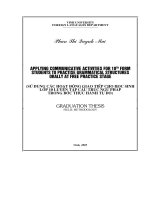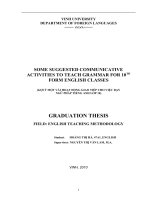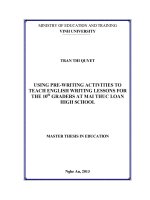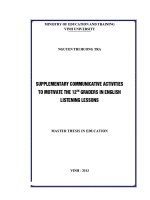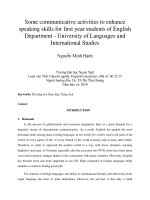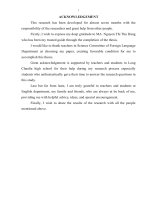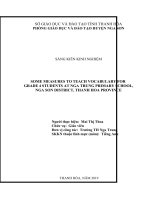Some suggested communicative activities to teach grammar for 10th form english classes
Bạn đang xem bản rút gọn của tài liệu. Xem và tải ngay bản đầy đủ của tài liệu tại đây (340.41 KB, 64 trang )
VINH UNIVERSITY
DEPARTMENT OF FOREIGN LANGUAGES
==== ====
SOME SUGGESTED COMMUNICATIVE
ACTIVITIES TO TEACH GRAMMAR FOR 10TH
FORM ENGLISH CLASSES
(GỢI Ý MỘT VÀI HOẠT ĐỘNG GIAO TIẾP CHO VIỆC DẠY
NGỮ PHÁP TIẾNG ANH LỚP 10)
GRADUATION THESIS
FIELD: ENGLISH TEACHING METHODOLOGY
Student:
HOÀNG THỊ HÀ, 47A1_ENGLISH
Supervisor: NGUYỄN THỊ VÂN LAM, M.A.
VINH, 2010
i
VINH UNIVERSITY
DEPARTMENT OF FOREIGN LANGUAGES
==== ====
HOÀNG THỊ HÀ
SOME SUGGESTED COMMUNICATIVE
ACTIVITIES TO TEACH GRAMMAR FOR 10TH
FORM ENGLISH CLASSES
(GỢI Ý MỘT VÀI HOẠT ĐỘNG GIAO TIẾP CHO VIỆC DẠY
NGỮ PHÁP TIẾNG ANH LỚP 10)
GRADUATION THESIS
FIELD: ENGLISH TEACHING METHODOLOGY
VINH, 2010
ii
ACKNOWLEDGEMENTS
My assignment would not have been completed without the valuable
assistance and encouragement of many people for whom I am grateful including
my teacher, my parents and my friends.
First, I would like to express my deep thanks to my supervisor, Mrs.
Nguyen Thi Van Lam, M.A who gave me valuable advice, guidance,
suggestions, and support.
I also want to give my sincere thanks to all teachers in the foreign
language department of Vinh university for their lectures and advice which are
very useful foe me to finish the study.
Furthermore, to complete this thesis, I cannot forget the support and
encouragement from my family and my good friends.
Finally, I wish to thank teachers and students in Phan Thuc Truc School,
who took part in my survey estimatedly.
Although the study has been done with all my attempts, my limitations of
ability and knowledge may cause mistakes in the study. Therefore, I would like
to receive any remarks and comment from anyone on my study.
Vinh, May 2010.
Hoang Thi Ha
iii
TABLE OF CONTENT
Page
VINH, 2010............................................................................................................................................................i
VINH, 2010...........................................................................................................................................................ii
ACKNOWLEDGEMENTS.........................................................................................................................................iii
LIST OF FIGURES.....................................................................................................................................................vii
PART 1: INTRODUCTION.........................................................................................................................................1
PART 2: DEVELOPMENT..........................................................................................................................................5
CHAPTER 1: THEORETICAL BACKGROUND.................................................................................................5
1.1 English Grammar.......................................................................................................................................5
1.1.1 Definition of Grammar......................................................................................................................5
1.1.2 Grammatical Structure.......................................................................................................................5
1.1.3 The role of Grammar in Learning Language.....................................................................................6
1.2 Communicative Language Teaching (CLT)..............................................................................................7
1.2.1 Characteristics of CLT.......................................................................................................................7
1.2.2 Teacher Roles in CLT........................................................................................................................9
1.2.3 Learner Roles in CLT......................................................................................................................10
1.3 Teaching Grammar in CLT.....................................................................................................................11
1.3.1 Grammar in CLT..............................................................................................................................11
1.3.3 Common Procedure in Teaching a New Structure..........................................................................13
1.3.4 Some Techniques in Teaching Grammar.........................................................................................15
CHAPTER 2: REAL SITUATION OF TEACHING............................................................................................17
AND LEARNING ENGLISH GRAMMAR AT PHAN THUC TRUC HIGH SCHOOL.........................................17
2.1 Overview about Learning and Teaching grammar in Vietnamese High School.....................................17
2.1.1 Teaching Grammar at Vietnamese High School.............................................................................17
2.1.2 Content of Grammar in the English 10th Form Textbook...............................................................18
2.1.3 Some Comments on Grammar Exercises and Activities in High School Text books for 10th Form
...................................................................................................................................................................19
2.2 Real Situation of Learning and Teaching English Grammar at Phan Thuc Truc High School...............20
2.2.1 Background Setting..........................................................................................................................20
2.2.2 The Real Situation of Learning and Teaching Grammar.................................................................20
2.3 Survey on Teaching and Learning English Grammar at Phan Thuc Truc High School..........................22
2.3.1 Aims of the Survey..........................................................................................................................22
2.3.2 Survey Setting..................................................................................................................................22
2.3.3 Description of the Survey Questionnaire.........................................................................................22
2.3.4 Results of the Survey.......................................................................................................................23
2.4 Summary..................................................................................................................................................36
CHAPTER 3: SOME SUGGESTED COMMUNICATIVE ACTIVITIES TO TEACH GRAMMAR FOR 10TH
FORM ENGLISH CLASSES...............................................................................................................................37
3.3.1 Information Gap.........................................................................................................................................38
3.3.2 Communicative Drills................................................................................................................................40
3.3.3 Reconstruction Activity............................................................................................................................40
3.3.4 Chain Drill Activity....................................................................................................................................42
3.3.5 Telling Story...............................................................................................................................................43
3.3.6 Picture Dictation........................................................................................................................................44
iv
3.3.7 Chain Story................................................................................................................................................45
3.3.8 Responding game......................................................................................................................................46
3.3.9 Don’t say “yes” or “no” game.................................................................................................................47
3.3.10 Matching game.........................................................................................................................................47
PART 3: CONCLUSION............................................................................................................................................49
REFERENCES.............................................................................................................................................................52
v
ABBREVIATIONS
CLT: Communicative Language Teaching
vi
LIST OF FIGURES
ACKNOWLEDGEMENTS.........................................................................................................................................iii
LIST OF FIGURES.....................................................................................................................................................vii
PART 1: INTRODUCTION.........................................................................................................................................1
PART 2: DEVELOPMENT..........................................................................................................................................5
PART 3: CONCLUSION............................................................................................................................................49
REFERENCES.............................................................................................................................................................52
vii
PART 1: INTRODUCTION
1. Reasons for Choosing the topic
The more society develops, the more important part communication plays
in every field of life: home school, work and beyond. Through communication,
we can change our thoughts, opinions, and information by speech, writing or
signs. It is only through communication that collaboration and cooperation
occur. Therefore, the author has really been interested in communication in
learning language through which people of different nations can communicate or
exchange the materials and spiritual values, make their knowledge and culture
richer and more diversified.
Aware of language’s function as a means of communication, many
researchers have been involved in the study of how to develop communication
to language learners. This is the first time the author has had a chance to learn
“Language teaching theory” and she has found that it is a very important
material for everyone who becomes teacher of English since it is a good way to
help learners practice communicative skills.
Nowadays, English is considered as an international language and is an
obligatory subject in high school. Together with teaching language skills such as
speaking, writing, listening and reading the role of grammar is undeniable. In
fact, learners are taught grammar to serve language skills learning. Without the
basic knowledge of grammar, students find it difficult to develop the others.
Because of the writing forms of examination in most high school, much of
grammatical knowledge is emphasized. However, many students are still afraid
of and bored with foreign language lessons, especially grammar lessons because
in these periods, they seem to be passive and learn by heart many grammatical
rules. Different from traditional method, which overemphasizes with grammar,
communication now is the main goal of learning English. Actually, in spite of
good grammar knowledge, many students are not able to express themselves
well as what they do in written form. That is a serious problem. Why do students
1
fail in communicating? How do teachers apply communicative language
teaching in grammar lessons? What activities can help them to motivate in
communication? These questions are many people’s concern. Being a student of
English now and a teacher of English in the near future, the author considers that
applying communicative activities in grammar lessons is very important. In
order to make teaching of English in general and grammar lessons in particular
more interesting and practical to pupils, the author has tried to do the research
into “Some Suggested Communicative Activities to Teach Grammar for 10 th
Form English Classes”.
2. Aims and Objectives of the Study
The study is conducted with the following aims:
- To help teachers aware of the importance of grammar and applying
activities to teach grammar communicatively.
- To get some information about the real situation of teaching and learning
grammar with creating and applying activities.
- To suggest some useful activities to motivate students and improve the
ability of communication for learners in grammar lessons.
In order to fully achieve these aims, the study answers the following
questions:
- What is grammar and how to teach English grammar communicatively?
- What is real situation of teaching and learning English grammar at Phan
Thuc Truc High School?
- What are communicative activities to be applied in grammar lessons?
3. Scope of the Study
The aim of the study is to suggest some activities to teach grammar
communicatively. The study is investigated in three classes: 10C2, 10C7, 10C9
at Phan Thuc Truc High School to find out the real situation of learning and
teaching grammar as well as activities used. Based on that, the author points out
2
some activities to teach grammar communicatively. This is suitable for the
results of the survey and knowledge of 10th form students.
4. Methods of the Study
To finish this study, the author has used quantitative and qualitative
approaches.
-
Firstly, the author collects the materials, which refer to CLT, grammar
and communicative activities in English grammar classes.
-
After that, she conducts a survey to get information about the real
situation of teaching and learning English grammar at Phan Thuc Truc
High School.
-
Next, she analyzes and synthesizes the collected data.
-
Finally, she discusses the suggested activities to teach grammar for 10 th
form classes.
5. Design of the Study
The study consists of three main parts: introduction, development and
conclusion.
“INTRODUCTION” presents the information about the reasons for
choosing the topic, the aims of the topic, the scope of the study, the method of
the study and the design of the study.
The second part “DEVELOPMENT” comprises three chapters. Chapter 1Theoretical Background discusses some main points relating to the topic. This
chapter consists of the general definition of grammar, grammatical structure and
its importance in learning language, CLT with some main characteristics,
teacher’s roles and learners’ roles and teaching grammar in CLT, which includes
the procedure, common principles, and some techniques. Chapter 2 is titled
“Real Situation of Teaching and Learning English Grammar at Phan Thuc
Truc High School”. In this chapter, the author mentions about overview of
learning and teaching grammar in Vietnamese High School, the situation of
teaching and learning reading at Phan Thuc Truc High School. Chapter 3
3
entitled “Some Suggested Communicative Activities to Teach Grammar for
10th Form English Classes”. It is the main content of the study, which provides
some suggested activities with the aim to motivate students in learning grammar.
The last part is “CONCLUSION”. This part summarizes the main points
discussed in the previous parts and offers some suggestions for further study.
The study ends with the “REFERENCES” which lists all the materials and
sources of information used in this study.
4
PART 2: DEVELOPMENT
CHAPTER 1: THEORETICAL BACKGROUND
1.1 English Grammar
1.1.1 Definition of Grammar
There have been so many definitions of grammar so far. According to
Penny Ur (1988), grammar may be roughly defined as the way a language
manipulates and combines words (or bits of words) in order to form longer units
of meaning. For example, in English, the present form of the verb “be” in the
third person has two distinct forms, one (is) being used with a singular subject,
and the other (are) with a plural, and if the plural “are” is combined with a
singular subject, the result is usually unacceptable or “ungrammatical”. Thus, a
sentence like “This is a book” is grammatical whereas “This are a book” is not.
There is a set of rules that govern how units of meaning may be constructed in
any language. It is said that a learner who “knows grammar” is one who has
mastered and can apply these rules to express him or herself in what would be
considered acceptable language forms.
According to Oxford Advanced learner’s dictionary, grammar is defined
as “the rules in a language for changing the form of words and combining them
in to sentences”. In other words, the field of grammar is often divided in to two
domains: morphology and syntax. The former focuses on the structure of words,
dealing with such matter as inflectional endings and the way words can be built
up out of smaller units, the latter focuses on the structure of sentence.
1.1.2 Grammatical Structure
Grammatical structure is the building blocks of language. It is usually
understood as a system of interrelated words, which makes a meaningful
utterance. The thing is what elements are needed to hold the relations of
utterances. Grammatical structures not only have form, but they are also used to
express meaning “semantics” in context and appreciate use “pragmatics” which
5
includes social context, linguistic discourse and presupposition about context
(Marianne Celce, Murcia).
A particular form may be used for different appropriate uses depending on
the context. This means that the form of an utterance by itself does not
determine the function. In other words, we cannot fully explain the form of
grammar while ignoring meaning and use. We cannot account the form of an
utterance by looking only at its meaning or function.
Having controlled a skeleton structure, we can create dozens or even
hundred of utterances. If the students can handle a range of useful structures in a
formulaic way, be aware of the functional value of each and able to substitute
the content to meet their communicative needs, then they getting what they
need.
1.1.3 The role of Grammar in Learning Language
The importance of grammar in learning language is undeniable. There is
no doubt that a language- implicit or explicit- of grammatical rules is essential
for the mastery of language. We cannot use words unless we know how they
should be put together.
Actually, a little use or incorrect use of grammar may lead to different
meanings and different understandings. Consider the following example:
I eat beef
I ate beef
Here we see that grammar and meaning are related to each other. There is
a meaning difference is communicated by grammatical structure in example 1
and grammatical structure in example 2.If a speaker has a wide vocabulary,
fluent speech, and clear pronunciation, they may sound strange or unintelligent
because their grammar is inappreciative as in the following example:
I acting beef
Tomorrow is coming John
6
Neither of these sentences is appropriate and no one saying them would
sound intelligent to a native speaker. Therefore, there is a place for emphasizing
grammatical correctness (cited in Nguyen Thi Van Lam and Ngo Dinh Phuong,
2007).
Learning grammar is considered the fundamental step to use and practice
four language skills: speaking, reading, listening, and writing. It is integrated in
these skills. That is why by incorporating forms included in tasks and activities
in a communicative classroom, students can apply traditional learning strategies
and styles to produce meaning. For example, prior to engaging in an oral
activity, an instructor should review the basis vocabulary and grammatical
expressions and allow the students the opportunity to prepare notes before
inviting oral responses.
As stated above, grammar is very important for learners to control
language skills. We can take an illustration of this for reading. Grammar
contains the aspect of syntactic or structure and grammatical cohesive devices,
referent items (E.g. “they”, “these”, “the latter”), substitution and ellipsis of
items (E.g. the deletion of relative pronounces such as which, that, who).
Readers are partly dependent on syntactic structures in order to get to meaning.
In other words, the aspect of grammar makes readers difficult in processing a
text. That is why focusing on grammar to develop not only reading but also
other skills is important. Grammar is a tool for language learners, which can
help them to see through the fog, communicate intelligently and see how they
see to acquire the language items.
1.2 Communicative Language Teaching (CLT)
1.2.1 Characteristics of CLT
CLT is one of the most popularly used approaches in language teaching. It
refers to a diverse set of features that reflects a communicative view of language
learning. CLT has been used in language teaching with two aims: make
communicative competence of the goal of language teaching and develop
7
procedures for teaching of the four language skills that knowledge the
interdependence of language and communication (cited in Nguyen Thi Van Lam
and Ngo Dinh Phuong, 2006). Practitioners of the approach try to focus on what
the pupils need to do with the language, not what they need to know about the
rules of it. Thus, from the first stage, instead of learning sentences like:
This is a book
That is a flower
Pupils are taught the function of “greeting and introduction” which give
them the same structures “this is, that is”. For example, the teacher introduces
the pupils to each other: Linh, this is Hoa and that is Nam. The listening and
speaking skills are practiced in natural and lively ways.
-
According to David Nunan(cited in Abdul Bari), CLT is seen as an
extension of the notional-functional syllabus. Therefore, it also places great
emphasis on helping students use the target language in a variety of contexts.
The focus of CLT is its importance of learning language functions. In this case,
it is important that the teacher supports learners in creating meaning rather than
helping them creating perfectly grammatical structures or acquiring native-like
pronunciation. Consequently, learning a foreign language with success is linked
to developing communicative competences. CLT is usually characterized as a
broad approach to teaching, rather than a teaching method with a clearly defined
set of classroom practices. As such, it is often defined as a list of general
principles or features. There are five features covered in CLT in David Nunan’s
point of view. Firstly, there is an emphasis on learning to communicate through
interaction in the target language. Communication is at CLT’s centre. Learning a
language does not make any sense, if learners only repeat language patterns they
have learnt by heart. They should rather be able to express themselves
appropriately in different communicative situations to gain communicative
competence. Secondly, there should be an introduction of authentic texts in to
the learning situation. Real language texts are important because they help
students find it easy to understand and encourage them to use language items.
8
Thirdly, the provision of opportunities for learners should focus, not only on the
language but also on the learning process itself. Fourthly, an enhancement of the
learner’s own personal experiences is considered as an important contributing
element to classroom learning. That is because students can be motivated in to
the lessons and participate excitedly in natural conversations by their own
personal experiences. Lastly, an attempt to link classroom language learning
with language activation outside the classroom should be made by the teacher.
The variety of activity will give students opportunities to interact with each
other and other people.
The teaching method in the CLT is not against the role of grammar in
learning language but considers it as one means to help students use the
language. Therefore, this approach has been widely used in many language
schools nowadays.
1.2.2 Teacher Roles in CLT
Teacher roles are an important part to create a positive classroom climate.
Several roles are assumed for teachers in CLT. Breen and Candlin (cited in
Nguyen Thi Van Lam and Ngo Dinh Phuong, 2006) describe two main roles of
the teacher. The first role is to facilitate the communicative process between all
participants in the classroom and between these participants and the various
activities and texts. The second role is to act as an independent participant
within the learning-teaching group. The latter role is closely related to the
objectives of the first role and arises from it. Teacher also acts as researcher and
learner, with much to contribute in terms of appropriate knowledge and abilities,
actual and observed experience to the nature of learning and organizational
capacities.
Other roles assumed for teachers are needed analyst, counselor and group
process manager. The CLT teacher assumes a responsibility for determining and
responding to learner language needs. Based on such needs assessments,
9
teachers are expected to plan group and individual instruction that responds to
learners’ needs.
To be a counselor, the teacher is expected to exemplify an effective
communicator seeking to maximize the meshing of speaker intention and hearer
interpretation with paraphrase, confirmation and feedback. CLT procedures
often require teachers to acquire less teacher-centered classroom management
skills. It is the teacher’s responsibility to organize the classroom as a setting for
communication and communicative activities.
1.2.3 Learner Roles in CLT
Learners are considered as the centre of language teaching and learning.
Therefore, the design of an instructional system will be considerably influenced
by how learners are needed. The emphasis in CLT on the processes of
communication, rather than the mastery of language forms, leads to different
roles for learners from those found in more traditional second language
classrooms. Breen and Candlin (cited in Nguyen Thi Van Lam and Ngo Dinh
Phuong, 2007) describe the learner’s role within CLT in the following terms:
“The role of learner as negotiator - between the self, the learning process,
and the object of learning – emerges from and interacts with the role of joint
negotiator within the group and within the classroom procedures and activities
that the group undertakes. The implication for the learner is that he should
contribute as much as he gains, and thereby learn in interdependent way”.
Therefore, students are expected to interact primarily with each other than
with the teacher. Once cooperative approach to learning is stressed in CLT,
learners are thought to bring preconceptions of what teaching and learning
should be like. They are negotiators, communicators and responsible managers
to managers of their own learning.
From the CLT point of view, we can see how the roles of the teacher and
learner change. Teachers in CLT will find themselves talking less and listening
more.
10
1.3 Teaching Grammar in CLT
1.3.1 Grammar in CLT
An influential analysis of communicative competence is found in Canal
and Swain (1980, cited in Nguyen Thi Van Lam and Ngo Dinh Phuong, 2007),
in which four dimensions of communicative competence are identified. One of
them is “grammatical competence”. “Grammatical competence” refers to what
Chomsky calls linguistic competence and what Hymes intends by what is
“formally possible”. It is the domain of grammatical and lexical capacity.
As grammar is seen as a communicative system in CLT, it should derive
from realistic situations and be used for a concrete purpose to enable learners to
express meanings by using as much appropriate forms as possible. Activities
included in teaching grammar should enable students to become active (learning
by doing) and teacher should set grammar in relation to what they need and are
interested in.
One important thing when teaching grammar in communicative situation
is that errors should not be overestimated or overemphasized as this can result in
a stressful and fearful classroom climate. This goes against the general goal to
make students more confident and increase their motivation for language
learning .
As far as grammar is concerned, CLT is an ideal choice, as it rather has
the learners in its centre than assessing the number of mistakes made. “Boring
grammar” can turn into various demanding, enjoyable games and tasks that
fulfill the goal to practice structures even better or equally well. Grammar
examples are taken from real life situations that make sense and are no longer
meaningless or boring invented illustrations. Furthermore, students learn that
grammar is meaningful and helps them to express their own ideas and achieve
speaking goals (grammar is a means to an end). In addition, rules that consider
the functions and notions of language are still relevant, but mainly taught by
means of activities, which facilitate their understanding.
11
1.3.2 Principles for Teaching Grammar.
Teaching grammar is still an argumentative problem. Each of the teachers
can have a different way of teaching which is suitable for students’ interest and
knowledge. However, it is very important for the teacher to follow the common
principles in any way so as to teach grammar more effectively and methodically.
Forseth (cited in Nguyen Thi Van Lam and Ngo Dinh Phuong, 2007) suggests
seven principles for teaching grammar.
Firstly, the teacher should remember to teach grammar implicitly. It means
that the teacher presents examples of the structure and allows students to focus
on meaning without teaching grammar rules. If the teacher focuses on the form
at the first time, students will be likely to feel discouraged for using language.
This will leads to production of unnatural speech after that.
Secondly, it is important to present a grammatical item orally before
presenting a written form and an explanation. That is because it is easier to focus
on the meaning when listening. Therefore, listening first will help students to
understand the meaning communicated by the grammatical item without paying
attention into form and explanation.
Thirdly, the teacher should use visual aids to help students see the structure
and the grammatical meaning. It must be clear for all students in the class to
notice. By using visual aids, the teacher makes the grammatical item easier to
understand.
Fourthly, the teacher should connect the form to meaning. In all cases,
students must be clear about the meaning even when the form is presented.
Thus, it is necessary for the teacher to keep students understanding the meaning
of the structure they are studying.
The fifth principle is that the teacher de-emphasizes the use of special items.
Using a lot of grammatical items like “aspect”, “gerund” will make students find
difficult to understand which can lead to a boring and an effective lesson. The
12
teacher only should use common words that are suitable for students’ level to
describe the language.
The next principle is to give positive feedback along with correction and
emphasize communication rather than just grammatical accuracy. If the teacher
only focuses on correction of grammatical accuracy, and corrects it all the time,
as a result, students will be discouraged of using language and their
communication will be failed. Similarly, the teacher should try to find positive
feedback to give for students. If not, they will be not motivated to continue
learning.
Lastly, after practicing a structure in a controlled exercise, teacher must give
students opportunities to use the structure in more free communication. One
lesson is only effective when students can communicate by themselves in a
natural way. Thus, being a teacher, try to create as many activities as possible to
help students to express the meaning of structure in free communication.
1.3.3 Common Procedure in Teaching a New Structure
A popular framework for teaching grammar based on examples or texts is
P.P.P (presentation – practice – production). Presentation of the new material
can be done with rules and examples. Practice of the target grammar is done in
drill exercises and more ones that are creative. The result can be production of
learners’ utterances (Byrne.D.1976).
1.3.2.1 Presentation
Presentation provides the structure input that gives students foundation for
their knowledge of the language grammar, helping them absorb the grammar
content.
We usually begin by presenting the class with a text in which the
grammatical structure appears. The aim of the presentation is to get the learners
to perceive the lecture – its form and meaning – in both speech and writing to
take it in to short-term memory.
13
Often, a story or a short dialogue is used which can appear in written form
and read aloud by the teacher and students. As a follow-up, students may read
aloud, repeat, reproduce for memory, or copy out instances of the use of the
structure. Where the structure is very simple, easily perceived one, the
presentation may be no more than a simple sentence or two, which serves as a
model. The explanation of the new structure should focus on grammatical items
themselves: what they look like, what they mean, how they function – in short,
what rules govern them. The objective is that the learners should understand
these various aspects of the new structure. It should be illustrated by plenty of
contextualized examples or visual material if possible.
1.3.2.2 Practice
The aim of this stage is to give students thorough practice of the items,
both in writing and speaking, so that they will be able to use them correctly and
fluently in a variety of contexts or their own. For this occur, we need to provide
activities from fully teacher-controlled, mechanical ones to less controlled and
more meaningful to produce communicative activities then. The former helps
students to “get their tongue around” or manipulate a new structure. As this type
of practice restricts individual’s contribution the latter is created to make the
students to think and understand what they are saying. Students need to be
thinking more actively. Practice should be more difficult and more useful or in
another way, to transfer from short-term to longer-term memory.
1.3.2.3 Production
At the production stage, learners are able to use structures freely for
communicative purposes. This step must be creative and communicative. It is
important as the goal of language teaching and learning is for communication.
Usually, they produce utterances about their own experiences, their life, their
family, etc. during this stage; there is a focus on what is said rather than on the
language itself. That makes the students feel that they are really using the
language for their need of communication. Students have the chance to use the
14
language freely and incorporate it in to their existing language. The emphasis at
this stage is on use and fluency.
1.3.4 Some Techniques in Teaching Grammar
Applying techniques in teaching grammar is the basis to create activities
to teach grammar communicatively. We seem to conclude that techniques are
more important than methods and approach for a teacher in his teaching a
foreign language. With a view to improve the classroom techniques for teaching
grammar, English teaching methodology (cited by Nguyen Thi Van Lam and
Ngo Dinh Phuong) have provided us some kinds of techniques which orient for
presenting and practicing new structures. From these techniques, activities are
created. An activity may be a combination of many techniques or a technique
can be integrated in various activities for the purposes of teaching and learning
grammar. In order to do so, it first considers the whole procedure for grammar
teaching which will be seen as a guideline for all the techniques presented
thereafter.
Some techniques for presenting the new structures are provided. These
consist of techniques for showing the meaning visually or through a situation.
As communication takes place in a particular situation, the teacher should be
careful in selecting a situation of grammatical items so that the correct meaning
and function of that item can be seen clearly without lengthy explanation. It is
noteworthy that the formation of skills happens more easily and rapidly when
the presentation of the new structure is similar to real life situation. By giving
several different examples, the teacher helps the class to build up a clear idea of
what the structure means and how it is used. In addition, visual aids can enliven
the lesson enormously if properly used visual aids make the lesson much more
interesting and easier for the pupils to remember than unlived sentences on the
board. Visual aids, furthermore, can attract the attention of the whole class.
Visual aids can be pictures, magazines cutout, and real objects. Simple black
board drawing can also help a lot in presenting structures. Anything available in
15
the class like pens, rules, etc can be used for the purpose of teaching structure.
Besides, other techniques for practicing structures are also given. Practices are
divided in to controlled and free practice at the last two stages of the completely
teaching procedure. It is dispensable in the process of language learning.
Practices transfer from drills based on repetition and restricted responses to less
controlled, more meaningful and then to communicative activities. Some
techniques for controlled practice here are those such as repletion, substitution,
fill-in-blank or reordering words or sentences. For free practice, we can account
some such as guided practice, topical practice or language games. As using these
techniques are important in language teaching procedure, teacher must be very
creative in building up activities which can include them to teach grammar
communicatively. This depends on the level of the class and stages in the whole
process.
16
CHAPTER 2: REAL SITUATION OF TEACHING
AND LEARNING ENGLISH GRAMMAR AT PHAN THUC
TRUC HIGH SCHOOL
2.1 Overview about Learning and Teaching grammar in Vietnamese High
School
2.1.1 Teaching Grammar at Vietnamese High School
High school students may differ in their purposes for learning English. In
fact, in spite of the goal of communication as a characteristic of communicative
language teaching, the students of English in Vietnam seem to fall into three
major categories. Some view English as a tool for more attractive and lucrative
employment opportunities, while others need a good language of English to
study further at a university. The majority of students, to which students at high
school belong, learn English just to pass the national examination. These
students do not have obvious communicative needs. All they need is a
sufficiently good knowledge of grammar and vocabulary to pass the national
grammar based examinations.
Currently, the two most important English examinations in Vietnam are
the school final examination and the university entrance examination. Neither
has a listening and speaking component. Due to the pressure to pass the
examinations, the teachers and students seem to focus more on language
knowledge than language use. Grammar knowledge for them is essential to give
correct answers, not to communicate or use language.
Not only do students find it critical to pass the examinations, teachers are
also very much concerned about the pass rate of their students, since they are
assessed basing on their students’ performance in examinations rather than on
the quality of their teaching. As a result, no matter what the learning purpose of
students might be, teachers have to make sure that their students achieve a high
pass rate in the examinations. Consequently, many students cannot apply them
17
in to communication because they do not know how to use these structures
appreciatively and are not given enough practice in their grammar class.
2.1.2 Content of Grammar in the English 10th Form Textbook
Grammatical content is included in Language focus. Language focus
consists of two main parts: the pronunciation part is designed to review the way
students pronunciate short sounds and long sounds (for both consonants and
vowels) in words and sentences. Grammar and vocabulary refer to grammatical
problems and some vocabulary, which are considered the centre of the lesson.
All of them are presented in the form of exercises or activities to give the
students the opportunities to practice in the class.
As mentioned above, because the content is mainly designed to review
and to consolidate the knowledge students have been taught before; grammatical
units are not difficult for them.
We can list some grammatical focus in the 10 th form textbook as the
followings:
Some basic tenses in English are introduced in the textbook including:
present simple tense, past simple tense, present continuous tense, present perfect
tense, past perfect tense, near future and simple future tense.
Passive voice of some simple tenses such as simple present tense, present
continuous tense and present perfect tense are presented.
Another grammatical point is conditional sentence, which includes the first,
second, and third conditional sentence type.
Students are also reviewed the way to make comparison with comparatives and
superlatives.
Some other minor structures such as “used to”, “although…”, “it was not
until…” are covered within teaching tenses.
18
